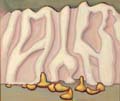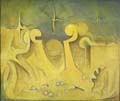recognition
(Also read manierre dawson and the armory show).

Nuts Against Sculptured Rock , 1913
Manierre Dawson
Click on image to enlarge with caption.
Manierre Dawson continued to make art throughout his adult life. He explored both painting and sculpture. For a brief discussion of his sculpture, see Nuts against Sculptured Rock (click on the image to the right).
In his early work (1908 - 1910) Dawson was unhampered by the academic training that was strangling students at formal institutions of art instruction. Being present to the spirit of the time, he felt compelled to bend space to his will and created a clearly personal vision of what art could be.
“This winter I am very hard at work Saturday and Sundays on several arbitrarily constructed paintings of arranged figures, blocking things out without rhyme or reason other than to make the picture look ‘right,’”2 he wrote in December of 1908.

Desert, 1920
Manierre Dawson
Click on image to enlarge with caption.
Upon his return from a European trip in 1910, Dawson set a goal for his painting with which he would go a long way toward reconciling his contemporary vision with that of European Old Masters. The resultant figurative works act as a sort of bridge between his fully abstract painting of early 1910 and the work inspired by his visits to the Armory Show when it arrived in Chicago in 1913.
Viewing cutting-edge European masterpieces in the Armory Show served to validate Dawson’s ideas about abstraction, spurred his creativity, and re-invigorated his commitment to painting as a career choice. It was immediately after this experience with the Armory Show that the young artist severed his ties with the architectural firm who had been employing him since his graduation from Armour Institute of Technology.

Two Arms, 1926
Manierre Dawson
Click image to enlarge with caption.
He pressed on in his pursuit of abstraction. His determination culminated in a group of paintings executed between 1913 and 1915 that seem to anticipate the work of the American Abstract Expressionist painters thirty years later. He accomplished this amid an environment that was just short of hostile to anything but the most conservative sorts of aesthetic experimentation.
Recognition of Dawson’s unique position within the history of abstraction in America began to emerge with an exhibition at the Grand Rapids Art Museum in 1966.Upon retirement to Florida in 1960, Dawson contacted the nearby John and Mabel Ringling Museum. Karl Nickel, a curator at the museum, recognized the possible importance of his work. In 1967, Dawson was given a solo show at the Ringling Museum. He was finally able to obtain gallery representation for his work. The first of numerous solo shows with the Robert Schoelkopf Gallery in New York opened in April, 1969.
Dawson's contributions have since been recognized in exhibitions at the Whitney Museum of American Art in New York and the Museum of Contemporary Art in Chicago.
Manierre Dawson died in Sarasota, Florida in August of 1969.

Essay in Brown, 1913
Manierre Dawson
Click on image to enlarge with caption.
Also read:
Manierre Dawson - a pioneer
Manierre Dawson and the Armory Show.
1 Manierre Dawson journal entry, November 30, 1910; Archives of American Art, Smithsonian Institution as quoted in Manierre Dawson: American Pioneer of Abstract Art; Hollis Taggart Galleries; New York, New York; 1999; Appendix I, p. 170.
2 Manierre Dawson journal entry, December 26, 1908; Archives of American Art, Smithsonian Institution as quoted in Manierre Dawson: American Pioneer of Abstract Art; Hollis Taggart Galleries; New York, New York; 1999; Appendix I, p. 160.